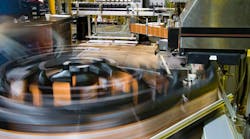Making the Case for DC Drives
With safety always a consideration on the plant floor, the use of low-voltage DC drives in some applications can be a strong alternative to AC drives or other power options for motion control.
A recent Machine Design story notes, “Some applications operate best with traditional AC drives and motors, but in certain cases, high-performance low-voltage DC drives are preferred. These include cases in which the application requires:
- Heightened human-safety due to DC drives’ lower electrical shock hazards than their AC counterparts and their ability to limit torque and speed to user-defined quantities.
- More precise motor movements because AC drives cannot provide the same quick speed and direction changes.
- Battery operation.
- Other cases when high-voltage AC is inaccessible or inconvenient.
Vaccines and Digital Transformation
Vaccines have been at the top of everyone’s mind in recent months, and the future need for COVID-19 vaccines is still being discussed. Overlooked to a certain extent is that there is far more going on in the pharma business than just one vaccine, and the need for accuracy combined with speed and flexibility is driving industry leaders to embrace digital transformation.
A new report, “Industry 4.0 in the Pharmaceutical Industry” from ABI Research, reports that the pharma industry is expected to invest $4.5 million in digital factories by 2030—a 27% year-over-year growth rate.
“Contract manufacturers look to digital technologies to enable them to support clients simultaneously,” ABI officials note in a press release. “After patents expire, generics manufacturers need to produce as many products as possible. The utilization of data analytics will support each type of manufacturer’s efforts to increase yield.”
And Michael Larner, industrial and manufacturing principal analyst at ABI Research, notes the need for flexibility and precision in planning is a paramount concern. “Manufacturers will need to invest in analytics to help develop digital twins of their operations so that they can prepare their production lines for continuous manufacturing,” Lerner said.
